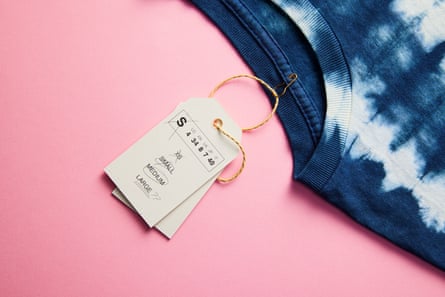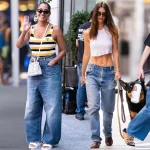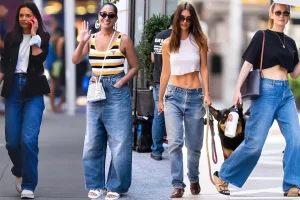Are you a 10 in one store and a 14 in another? We examine what’s behind this sizing crisis – and how to solve it
In my wardrobe, I have a long Cos dress with a label that reads XS. A similar style from Doen is labelled M – theoretically a whole two sizes up, while a Topshop dress that always feels a little on the large side is labelled a 6. Weird. A vintage mini that I can’t get on without undoing the zip is a 14, and two Asos denim jumpsuits are an 8 and a 10 respectively – and don’t even get me started on jeans. Despite this, all these clothes fit just fine.
The size and shape of my body has remained more or less the same for years – it’s the ability to know whether or not a purchase will fit that has fluctuated. Ask any woman, and they’ll tell you that finding the perfect T-shirt in, say, a size 10 from one brand doesn’t mean you’ll fit size 10 T-shirts everywhere. You may not even fit other size 10 T-shirts from the same shop. What’s behind this sizing debacle?
In the UK, more than a fifth of all clothes bought online are sent back. According to the British Fashion Council, incorrect sizing or fit was the top reason for returns (93%). Whenever I return a purchase, retailers want to know why. Was an incorrect item received? Was it damaged? Did I order more than one size? Or did the size ordered not fit? Usually, for me, it’s the latter.
“I think it would be better to get rid of sizes 10, 12, 14, 16 – they’re meaningless,” says Simeon Gill, senior lecturer in fashion technology at the University of Manchester. “Let’s move into a bust, waist, hip system – that’s essentially what online retail is doing. It’s just that it’s also retained this outmoded idea of 10, 12, 14, 16.”
The move is, he says, born of retailers’ desire to reduce returns. “In the 1990s, you’d buy a garment and if it didn’t fit you’d take it back and they might say: ‘You should have tried it on; you can only have a credit note.’” When buying online, there’s no way to know if a garment will fit, so you’re eligible for a refund. There’s been a flip in who’s responsible – and a move towards informing the consumer.”
Although people have, generally, got bigger over the past 50 years, sizes have become smaller
But how many of us know our vital statistics? In the UK, retailers decide independently what constitutes a given clothes size, with the exception of cup sizes for bras. A “fit model” acts as a living mannequin during the design process, and clothing patterns are then graded up and down. But fit models are chosen largely on preference, not industry-wide standards. If a brand is aiming to appeal to teens, for example, they’re more likely to choose a teenage fit model.
“Brands decide on their target market, and size products according to what will make customers happy,” says Shingo Tsukamoto, president of sizing technology specialist Makip. This is why a size 8 at Urban Outfitters may fit differently to a size 8 at Dorothy Perkins.
“I once worked with a company where the female fit model was 21 and athletic and the male fit model was 42 and going to seed,” says Gill. “So if a father and daughter had wanted to shop there, great! But a mother and son would have had an issue.” There can also be sizing discrepancies between high street and designer: a US study found more expensive women’s trousers run larger than those of cheaper brands that were labelled the same size.

The past decade has also seen the proliferation of genderless clothing. In July, Vogue suggested this could be “creating collections that are gender-neutral by design but not by fit or size”. Vague sizing seems to be the preference, with retailers such as Uniqlo and Asos opting for the S, M and L labelling more commonly found in menswear.
There’s also the issue of “vanity sizing”: clothes labelled more generously based on the assumption that many of us wouldn’t mind dropping a size or two. This is responsible for sizes changing over time, which makes it more difficult to shop for vintage or secondhand. So although people have, generally, got bigger over the past 50 years, size numbers have got smaller: data from the Washington Post in 2015 found a US size 8 dress (a UK 12) to be nearly the equivalent of a US 16 (UK 20) in 1958.
Clothes sizing also differs internationally, which is an added complication given how many garments are shipped around the world. Clothes may also come up bigger or smaller depending on where they are predominantly sold. “A global brand will generally have different sizes according to its target region,” says Tsukamoto. “The US and Europe are typically one size larger than Asia.”
Never knowing your size can be time-consuming and disheartening. TikTokers and Instagrammers have taken to calling out brands for their sizing discrepancies and the disappointment it can cause (Zara often appears to be in the line of fire).
“It serves to undermine an already messed-with sense of our own bodies,” says psychotherapist Susie Orbach, who has found her clothes size can vary from a 2 to a 12. “If we were comfortable in our bodies, it would just be an inconvenience, but since the fashion industry helps breed body insecurity, we can understand this as part of the harm.”
Heather Radke, author of Butts: A Backstory, agrees: “Many of us feel we should fit ourselves into clothes, rather than having the clothes fit us. Almost everyone I’ve spoken to said they end up feeling sort of ‘wrong-bodied’.”
The solution? Some brands are going for “one size fits most”. Swimwear specialist Hunza G claims anyone from a UK size 6 to 16 can wear its items. “It removes insecurity and anxiety,” says chief executive Beverly Hill. “You can wear our product through every stage in your life,” she adds, “pre-, during and post-pregnancy, through any kind of weight fluctuation.”
This is good news for anyone hoping to keep clothes for years. The brand says its returns rate is less than half the industry standard. “Most returns are a result of unsuitable style or colour,” says Hill.
This, of course, is easier with the stretchy fabrics commonly found in sportswear and swimwear. Some brands, such as Brandy Melville, have received criticism for their one-size-only policy – especially when the size in question is relatively small and in less forgiving styles and fabrics.
One solution is universal sizing: an industry standard to which all brands would have to conform. “That could be disastrous,” says Gill. “Even if you had two people ostensibly the same size, the shape and distribution of their body might differ. If sizing was standardised, what would the standard be?”

Tsukamoto agrees: “Such a system could enhance efficiency in manufacturing, but it would need to navigate the complexities of cultural and regional variations in body types and preferences.”
In the meantime, “digital fitting rooms” such as Virtusize, True Fit and Makip’s Unisize, attempt to lessen the rate of returns. These can be part of the brand’s website – as at Boden – or used by customers independently. Typically, users input their height and weight, and choose a body shape (from illustrations) or submit photographs to help them find the right size.
Of course, it’s not foolproof. “Someone recently suggested that it would be good if online retailers just said ‘This won’t fit you’,” says Gill, “but I don’t think the industry would want to lose sales.”
There is another option: going bespoke. Or getting off-the-peg clothes adjusted by a local tailor. “Not only do your clothes fit properly but it helps them look more elevated,” says Sarah Ellis, co-founder of fashion platform We Are Twinset, who spends up to £200 a year on alterations at a local tailor whether it’s adjusting a high street jumpsuit or shortening a pair of jeans. She says it saves money in the long term as it stops her buying so many new clothes: “If something fits you well, no matter where it’s from, you’re naturally drawn to rewearing it rather than searching for something else.” It also means she can adapt old clothes if she wants to switch things up: “Recently I had a Mango vest I bought a few years ago made shorter – I loved it tucked in but it was too long in the body. Now I know I’ll keep it for a long time as it finally suits my shape.”
The final option, going totally bespoke, would mean buying far fewer clothes, but, “if you had five pieces of clothing tailored to your body, they would all fit”, says Radke. “So the answer may be something none of us is totally willing to do, which is to change our relationship with clothes and how many we have.”
How to find the perfect fit
Take your clothes shopping
“Get a garment you already own that fits well, and take it with you,” advises fashion technology expert Simeon Gill. “Just hold it up against the garment that you’re looking to buy, which will give you a reasonably good idea of whether it’s going to work.”
Know your measurements
Knowing these precisely, rather than just your vague size, can be a big help. “I always have a tape measure in my bag,” says Guardian menswear editor Helen Seamons.
“For a T-shirt, lay it flat, measure underarm to underarm, and the middle of the neck at the back to the hem.
“If you’re buying from a resale site, like Depop or Vinted, ask the seller to send you these measurements – but remember that some fabrics stretch more than others.” Bust, waist, hip and inseam measurements are also handy.
Look for different ‘fits’
Increasingly, brands are offering a range of fits, as well as sizes – such as Topshop’s “hourglass” range, which sits alongside its “petite”, “tall” and “curve” collections.
“The brand Asket does jeans in two ‘builds’: straight and curvy,” says Guardian styling editor Melanie Wilkinson, “and the latter is so much better for me.”
If in doubt, size up
It’s usually better to give yourself a little wriggle room. “Going for a slightly larger size is often a safer bet,” says Seamons, particularly on high street clothes.
Source : The Guardian




























